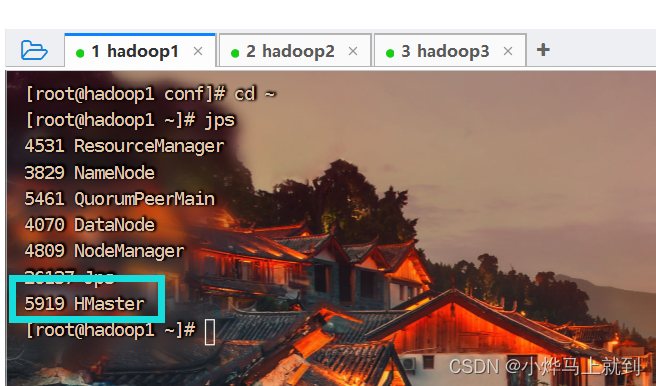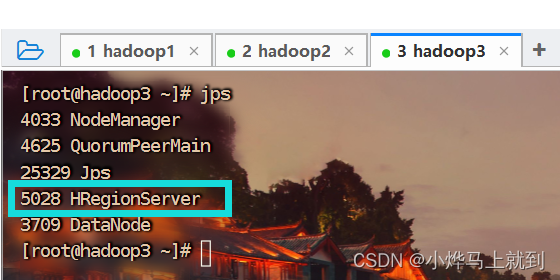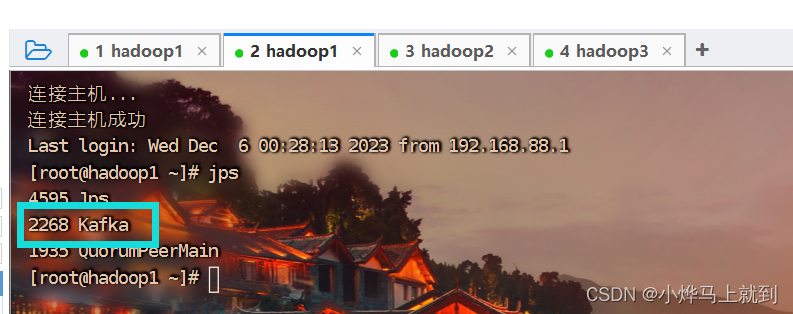一、安装HBase集群
1.下载HBase
Index of /dist/hbase/1.2.1 (apache.org) https://archive.apache.org/dist/hbase/1.2.1/安装HBase
https://archive.apache.org/dist/hbase/1.2.1/安装HBase
tar -zxvf /export/software/hbase-1.2.1-bin.tar.gz -C /export/server/
1.修改配置文件hbase-env.sh
在HBase安装目录下的conf目录,执行“vim hbase-env.sh”命令编辑HBase配置文件hbase-env.sh,配置HBase运行时的相关参数。
# 指定JDK安装目录。 export JAVA_HOME=/export/servers/jdk1.8.0_161 #指定不使用内置的ZooKeeper export HBASE_MANAGES_ZK=false
把这里注释打开自己设置目录避免后续报错
在这里将如图两行代码注释掉
 2.修改配置文件hbase-site.xml
2.修改配置文件hbase-site.xml
在HBase安装目录下的conf目录,执行“vi hbase-site.xml”命令编辑HBase配置文件hbase-site.xml,配置HBase相关参数。
hbase.rootdir #HBase集群中所有HRegionServer共享目录,用来持久化HBase的数据hdfs://hadoop1/hbase hbase.cluster.distributed #设置HBase的存储模式为分布式存储true hbase.zookeeper.quorum #设置ZooKeeper的服务器地址hadoop1:2181,hadoop2:2181,hadoop3:2181
3.修改配置文件regionservers
在HBase安装目录下的conf目录,执行“vi regionservers”命令编辑HBase配置文件regionservers,配置运行HRegionServer所在的服务器主机名
hadoop2
hadoop3
4.复制Hadoop配置文件到hbase的conf目录下
进入Hadoop安装目录的conf目录,将配置文件core-site.xml和hdfs-site.xml复制到HBase安装目录下的conf目录,用于HBase启动时读取Hadoop的核心配置信息和HDFS配置信息。
cd /export/server/hadoop/etc/hadoop/
cp hdfs-site.xml /export/server/hbase-1.2.1/conf/
cp core-site.xml /export/server/hbase-1.2.1/conf/
5.配置备用HMaster
在HBase安装目录下的conf目录,执行“vim backup-masters”命令编辑备用HMaster配置文件backup-masters,配置备用HMaster所在的服务器主机名hadoop2。
hadoop2
6.分发HBase安装目录
为了便于快速配置HBase集群中其他服务器,将虚拟机hadoop1中的HBase安装目录分发到虚拟机Spark02和Spark03。
scp -r /export/servers/hbase-1.2.1/ hadoop2:/export/servers/ scp -r /export/servers/hbase-1.2.1/ hadoop3:/export/servers/
7. 配置HBase环境变量
分别在虚拟机hadoop1、hadoop2和hadoop3,执行“vi /etc/profile”命令编辑系统环境变量文件profile,配置HBase环境变量。
export HBASE_HOME=/export/servers/hbase-1.2.1 export PATH=$PATH:$HBASE_HOME/bin
系统环境变量文件profile配置完成后保存并退出即可,随后执行“source /etc/profile”命令初始化系统环境变量使配置内容生效。
二、 启动HBase集群
确保hadoop集群和Zookeeper集群已经启动
start-all.sh
zkServer.sh start #没有配置脚本的话每台机器都要执行这句话
start-hbase.sh



三、安装Kafka集群
1.下载并上传Kafka安装包,下面是下载官网
Apache Kafka https://kafka.apache.org/downloads2.安装Kafka
https://kafka.apache.org/downloads2.安装Kafka
tar -zxvf /export/software/kafka_2.11-2.0.0.tgz -C /export/servers/
3.修改配置文件server.properties
在Kafka安装目录下的config目录,执行“vim server.properties”命令编辑Kafka配置文件server.properties,配置Kafka的相关参数。
最重要的五个配置我用颜色进行了标注
# Licensed to the Apache Software Foundation (ASF) under one or more # contributor license agreements. See the NOTICE file distributed with # this work for additional information regarding copyright ownership. # The ASF licenses this file to You under the Apache License, Version 2.0 # (the "License"); you may not use this file except in compliance with # the License. You may obtain a copy of the License at # # http://www.apache.org/licenses/LICENSE-2.0 # # Unless required by applicable law or agreed to in writing, software # distributed under the License is distributed on an "AS IS" BASIS, # WITHOUT WARRANTIES OR CONDITIONS OF ANY KIND, either express or implied. # See the License for the specific language governing permissions and # limitations under the License. # see kafka.server.KafkaConfig for additional details and defaults ############################# Server Basics ############################# # The id of the broker. This must be set to a unique integer for each broker. #全局唯一编号 broker.id=0 ############################# Socket Server Settings ############################# # The address the socket server listens on. It will get the value returned from # java.net.InetAddress.getCanonicalHostName() if not configured. # FORMAT: # listeners = listener_name://host_name:port # EXAMPLE: # listeners = PLAINTEXT://your.host.name:9092 #listeners=PLAINTEXT://:9092 # Hostname and port the broker will advertise to producers and consumers. If not set, # it uses the value for "listeners" if configured. Otherwise, it will use the value # returned from java.net.InetAddress.getCanonicalHostName(). #advertised.listeners=PLAINTEXT://your.host.name:9092 #用来监听链接的端口,producer和consumer在此端口建立连接 port=9092 # Maps listener names to security protocols, the default is for them to be the same. See the config documentation for more details #listener.security.protocol.map=PLAINTEXT:PLAINTEXT,SSL:SSL,SASL_PLAINTEXT:SASL_PLAINTEXT,SASL_SSL:SASL_SSL # The number of threads that the server uses for receiving requests from the network and sending responses to the network num.network.threads=3 # The number of threads that the server uses for processing requests, which may include disk I/O num.io.threads=8 # The send buffer (SO_SNDBUF) used by the socket server socket.send.buffer.bytes=102400 # The receive buffer (SO_RCVBUF) used by the socket server socket.receive.buffer.bytes=102400 # The maximum size of a request that the socket server will accept (protection against OOM) socket.request.max.bytes=104857600 ############################# Log Basics ############################# # A comma separated list of directories under which to store log files #kafka运行日志存放路径 log.dirs=/export/data/kafka # The default number of log partitions per topic. More partitions allow greater # parallelism for consumption, but this will also result in more files across # the brokers. num.partitions=2 # The number of threads per data directory to be used for log recovery at startup and flushing at shutdown. # This value is recommended to be increased for installations with data dirs located in RAID array. num.recovery.threads.per.data.dir=1 ############################# Internal Topic Settings ############################# # The replication factor for the group metadata internal topics "__consumer_offsets" and "__transaction_state" # For anything other than development testing, a value greater than 1 is recommended for to ensure availability such as 3. offsets.topic.replication.factor=1 transaction.state.log.replication.factor=1 transaction.state.log.min.isr=1 ############################# Log Flush Policy ############################# # Messages are immediately written to the filesystem but by default we only fsync() to sync # the OS cache lazily. The following configurations control the flush of data to disk. # There are a few important trade-offs here: # 1. Durability: Unflushed data may be lost if you are not using replication. # 2. Latency: Very large flush intervals may lead to latency spikes when the flush does occur as there will be a lot of data to flush. # 3. Throughput: The flush is generally the most expensive operation, and a small flush interval may lead to excessive seeks. # The settings below allow one to configure the flush policy to flush data after a period of time or # every N messages (or both). This can be done globally and overridden on a per-topic basis. # The number of messages to accept before forcing a flush of data to disk #log.flush.interval.messages=10000 # The maximum amount of time a message can sit in a log before we force a flush #log.flush.interval.ms=1000 ############################# Log Retention Policy ############################# # The following configurations control the disposal of log segments. The policy can # be set to delete segments after a period of time, or after a given size has accumulated. # A segment will be deleted whenever *either* of these criteria are met. Deletion always happens # from the end of the log. # The minimum age of a log file to be eligible for deletion due to age log.retention.hours=168 # A size-based retention policy for logs. Segments are pruned from the log unless the remaining # segments drop below log.retention.bytes. Functions independently of log.retention.hours. #log.retention.bytes=1073741824 # The maximum size of a log segment file. When this size is reached a new log segment will be created. log.segment.bytes=1073741824 # The interval at which log segments are checked to see if they can be deleted according # to the retention policies log.retention.check.interval.ms=300000 log.cleaner.enable=true ############################# Zookeeper ############################# # Zookeeper connection string (see zookeeper docs for details). # This is a comma separated host:port pairs, each corresponding to a zk # server. e.g. "127.0.0.1:3000,127.0.0.1:3001,127.0.0.1:3002". # You can also append an optional chroot string to the urls to specify the # root directory for all kafka znodes. # broke需要使用zookeeper保存meta数据 zookeeper.connect=hadoop1:2181,hadoop2:2181,hadoop3:2181 # Timeout in ms for connecting to zookeeper zookeeper.connection.timeout.ms=6000 delete.topic.enable=true # 设置本机IP host.name=hadoop1 ############################# Group Coordinator Settings ############################# # The following configuration specifies the time, in milliseconds, that the GroupCoordinator will delay the initial consumer rebalance. # The rebalance will be further delayed by the value of group.initial.rebalance.delay.ms as new members join the group, up to a maximum of max.poll.interval.ms. # The default value for this is 3 seconds. # We override this to 0 here as it makes for a better out-of-the-box experience for development and testing. # However, in production environments the default value of 3 seconds is more suitable as this will help to avoid unnecessary, and potentially expensive, rebalances during application startup. group.initial.rebalance.delay.ms=0
4.添加环境变量
export KAFKA_HOME=/export/server/kafka_2.11-2.0.0
export PATH=$PATH:$KAFKA_HOME/bin
5.分发文件
scp -r /export/server/kafka_2.11-2.0.0/ hadoop2:/export/server/
scp -r /export/server/kafka_2.11-2.0.0/ hadoop3:/export/server/
scp /etc/profile hadoop2:/etc/profile
scp /etc/profile hadoop3:/etc/profile
6.修改配置文件
将hadoop2和hadoop3config目录中server.properties的参数broker.id的值分别修改为“1”和“2”,以及本机IP修改为对应的IP hadoop2和hadoop3
#全局唯一编号
broker.id=0
# 设置本机IP
host.name=hadoop1
四、启动Kafka集群
启动kafka集群前需要先启动Zookeeper集群服务
三台机器分别
zkServer.sh start
Zookeeper服务启动后就进入到Kafka的根目录下执行
bin/kafka-server-start.sh config/server.properties

再复制一个标签页查看是否启动服务

猜你喜欢
网友评论
- 搜索
- 最新文章
- 热门文章
